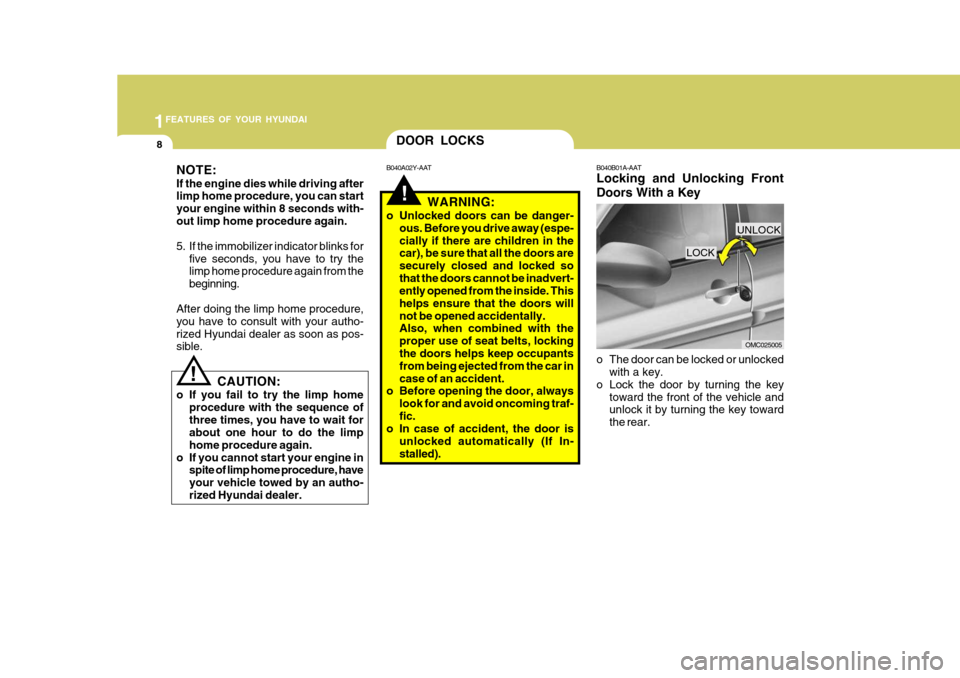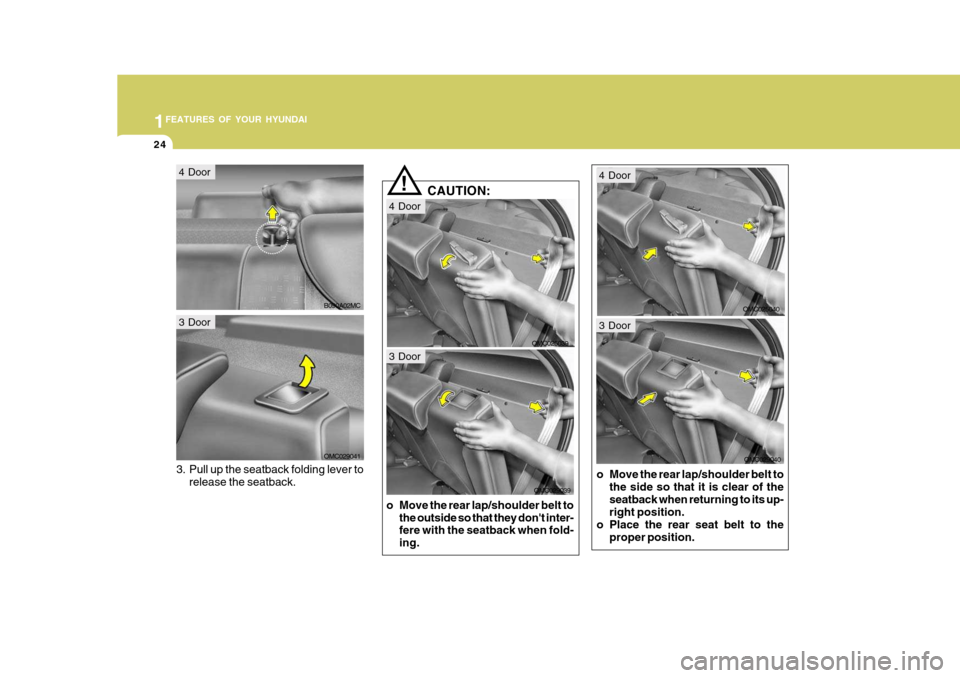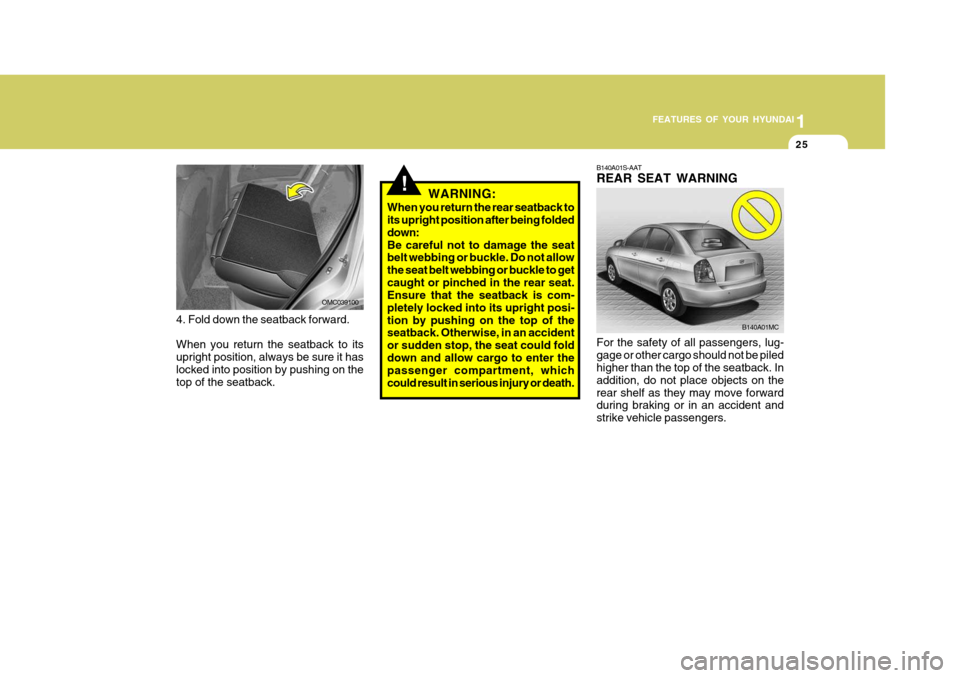2010 Hyundai Accent belt
[x] Cancel search: beltPage 12 of 284

YOUR VEHICLE AT A GLANCE
F12B255A03MC-GAT INDICATOR SYMBOLS ON THE INSTRUMENT PANEL * More detailed explanations of these items will be found begining on page 1-60.
Turn Signal Indicator Lights
SRS (Airbag) Service Reminder Indicator (If Installed) O/D OFF Indicator Light (Automatic transaxle only) High Beam Indicator Light
Low Oil Pressure Warning Light
ABS Service Reminder Indicator (If Installed)
Door Ajar Warning Light
Parking Brake/Low Brake Fluid Level Warning Light
Charging System Warning Light Fuel Filter Warning Light (Diesel only)
Low Fuel Level Warning Light Diesel Pre-heat Indicator Light (Diesel only)
Malfunction Indicator Light (If Installed)
Immobilizer Warning Light (If Installed)
Passenger's Front Airbag OFF Indicator Light (If Installed)
Trunk Lid/Tail Gate Open Warning Light
Engine Coolant Temperature Warning Light Seat Belt Warning Light
Electronic Power Steering (EPS) System Warning Light (If Installed)
Electronic Stability Program Indicator Lights (If Installed)
120
km/hOverspeed Warning Light (If Installed)
Automatic Transaxle Position Indicator Light (If Installed)
Page 13 of 284

Fuel Recommendations ................................................ 1-2
Breaking In Your New Hyundai .................................... 1-5
Keys ............................................................................. 1-5
Immobilizer System ...................................................... 1-6
Door Locks ................................................................... 1-8Theft-Alarm S ystem ..................................................... 1-10
Window Glass ............................................................. 1-14
Seats ........................................................................... 1-16
Seat Belts .................................................................... 1-26
Child Restraint System ................................................ 1-34
Supplemental Restraint (Airbag) System.................... 1-44
Instrument Cluster and Indicator Lights .......................1-56
Warning and Indicator Lights....................................... 1-60
Trip Computer .............................................................. 1-73
Multi-function Light Switch ........................................... 1-75
Windshield Wiper/Washer Switch ................................1-78
Sunroof ........................................................................ 1-87
Mirror ........................................................................... 1-92
Hood R elease .............................................................. 1-96
Heating and Cooling Control ...................................... 1-106
Stereo Sound System ............................................... 1-122
Antenna ..................................................................... 1-126
Audio System ............................................................ 1-127
FEATURES OF YOUR HYUNDAI
1
1
Page 20 of 284

1FEATURES OF YOUR HYUNDAI
8
!
DOOR LOCKS
NOTE: If the engine dies while driving after limp home procedure, you can start your engine within 8 seconds with-out limp home procedure again.
5. If the immobilizer indicator blinks for five seconds, you have to try the limp home procedure again from the beginning.
After doing the limp home procedure,you have to consult with your autho-rized Hyundai dealer as soon as pos- sible.
! CAUTION:
o If you fail to try the limp home procedure with the sequence of three times, you have to wait for about one hour to do the limp home procedure again.
o If you cannot start your engine in spite of limp home procedure, haveyour vehicle towed by an autho-rized Hyundai dealer.
B040A02Y-AAT B040B01A-AAT
Locking and Unlocking Front Doors With a Key
WARNING:
o Unlocked doors can be danger- ous. Before you drive away (espe- cially if there are children in the car), be sure that all the doors are securely closed and locked sothat the doors cannot be inadvert- ently opened from the inside. This helps ensure that the doors willnot be opened accidentally. Also, when combined with the proper use of seat belts, locking the doors helps keep occupants from being ejected from the car incase of an accident.
o Before opening the door, always
look for and avoid oncoming traf-fic.
o In case of accident, the door is
unlocked automatically (If In-stalled). o The door can be locked or unlocked
with a key.
o Lock the door by turning the key
toward the front of the vehicle and unlock it by turning the key toward the rear.
LOCK
UNLOCK
OMC025005
Page 30 of 284

1FEATURES OF YOUR HYUNDAI
18
!WARNING:
To minimize risk of severe injury in the event of a collision or a sudden stop, both the driver and passenger seatbacks should always be in anupright position while the vehicle is in motion. The protection provided by the seat belts and airbags in afrontal collision may be reduced sig- nificantly when the seatbacks are reclined. There is greater risk thatthe driver and passenger will slide under the seat belt which may result in serious injury if a crash occurswhen the seatbacks are reclined. The seat belt cannot provide full protec- tion to an occupant if the seatback isreclined.!WARNING:
o For maximum effectiveness in case of an accident, the headrest should be adjusted so the middle of theheadrest is at the same height of the center of gravity of an occupant's head. Generally, thecenter of gravity of most people's head is similar with the height of the top of their eyes. Also, adjustthe headrest as close to your head as possible. For this reason, the use of a cushion that holds thebody away from the seatback is not recommended.
o Do not operate the vehicle with the
headrests removed as severe in-jury to the occupants may occur in the event of an accident. Head-rests may provide protection against neck injuries when prop- erly adjusted.
o Do not adjust the headrest posi- tion of the driver's seat while thevehicle is in motion.
C010104AMC Headrest
The driver's and front passenger's seats are equipped with a headrest for the occupant's safety and comfort.The headrest not only provides comfort for the driver and front passenger, but also helps to protect the head and neckin the event of a collision. OBH038075L
Page 35 of 284

1
FEATURES OF YOUR HYUNDAI
23
o Before folding the seatback, insert the buckle in the pocket. This can prevent the buckle from being dam- aged by the seatback.
B110A01MC
!
B110A02MC-AAT Folding Rear Seatbacks (If Installed) The rear seatbacks may be folded to facilitate carrying long items or to in-crease the luggage capacity of the vehicle.
WARNING:
The purpose of the fold-down rearseatbacks is to allow you to carry longer objects than could otherwise be accommodated. Never allow passengers to sit on topof the folded down seatback or cargo area while the car is moving as this is not a proper seating position andno seat belts are available for use. This could result in serious injury or death in case of an accident or sud-den stop. Objects carried on the folded down seatback should not extend higher than the top of thefront seats. This could allow cargo to slide forward and cause injury or damage during sudden stops.To fold down the seatback :
1. Slide the front seats forward and adjust the front seatbacks to be up- right before folding the rear seatbacks down.
2. Lower the rear seat headrests to the lowest position.
B220D05MC
CAUTION:
!
o In order to prevent the center shoul- der belt from being damaged while folding the rear seat, disconnect the metal tab (A) from the buckle(B). To disconnect the metal tab (A) from the buckle (B) , insert a nar- row-ended tool into the groove lo-
cated on the buckle (B) (If Installed).
Page 36 of 284

1FEATURES OF YOUR HYUNDAI
24
3. Pull up the seatback folding lever torelease the seatback. CAUTION:
!
o Move the rear lap/shoulder belt to the outside so that they don't inter- fere with the seatback when fold- ing.
B090A02MC
OMC029041
4 Door
3 Door
OMC025039
OMC029039
4 Door
3 Door
o Move the rear lap/shoulder belt tothe side so that it is clear of the seatback when returning to its up- right position.
o Place the rear seat belt to the proper position.
OMC025040
OMC029040
4 Door
3 Door
Page 37 of 284

1
FEATURES OF YOUR HYUNDAI
25
B140A01MC
B140A01S-AAT REAR SEAT WARNING For the safety of all passengers, lug- gage or other cargo should not be piled higher than the top of the seatback. In addition, do not place objects on therear shelf as they may move forward during braking or in an accident and strike vehicle passengers.
!WARNING:
When you return the rear seatback to its upright position after being folded down:Be careful not to damage the seat belt webbing or buckle. Do not allow the seat belt webbing or buckle to getcaught or pinched in the rear seat. Ensure that the seatback is com- pletely locked into its upright posi-tion by pushing on the top of the seatback. Otherwise, in an accident or sudden stop, the seat could folddown and allow cargo to enter the passenger compartment, which could result in serious injury or death.
OMC039100
4. Fold down the seatback forward. When you return the seatback to its upright position, always be sure it has locked into position by pushing on the top of the seatback.
Page 38 of 284

1FEATURES OF YOUR HYUNDAI
26SEAT BELTS
B150A02A-GAT SEAT BELT PRECAUTIONS All occupants of the vehicle should wear their seat belts at all times. In-deed, your province's laws may require that some or all occupants of the ve- hicle use seat belts.The possibility of injury or the severity of injury in an accident will be de- creased if this elementary safety pre-caution is observed. In addition, follow the other instructions provided in this section. B150B01Y-GAT Infant or Small Child Some countries require the use of child restraint systems for infants and small children. Whether this is required by lawor not, it is strongly recommended that a child restraint seat or infant restraint system be used for infants or smallchildren weighing less than 18 kilo- grams (40 pounds). NOTE: Small children are best protected in an accident when properly restrained by a child restraint system. B150C02A-AAT Larger Children Children who are too large for child re- straint systems should always occupy the rear seat and use the available lap/ shoulder belts. The lap portion should be fastened snug on the hips and as low as possible. Check belt fit periodically. A child's squirming could put the belt out of position. Children are afforded the most safety in the event of an accident when they are restrained by a proper restraint system in the rear seat. If a larger child (over age 13) must be seated in the front seat, the child should be securely re- strained by the available lap/shoulder belt and the seat should be placed in the rearmost position. Children under the age of 13 should be restrained securely in the rear seat. NEVER place a child under the age of 13 in the front seat. NEVER place a rear facing child seat in the front seat of a vehicle.
C020302AKM Restraint of pregnant women Pregnant women should wear lap/shoul- der belt assemblies whenever possible according to specific recommendationsby their doctors. The lap portion of the belt should be worn AS SNUGLY AND LOW AS POSSIBLE. B150E01A-AAT Injured Person A seat belt should be used when an injured person is being transported.When this is necessary, you should consult a physician for recommenda- tions. B150F01A-AAT One Person Per Belt Two people (including children) should never attempt to use a single seat belt. This could increase the severity of injuries in case of an accident.
!WARNING- Pregnant
women
Pregnant women must never place the lap portion of the safety belt over the area of the abdomen where thefetus is located or above the abdo- men where the belt could crush the fetus during an impact.